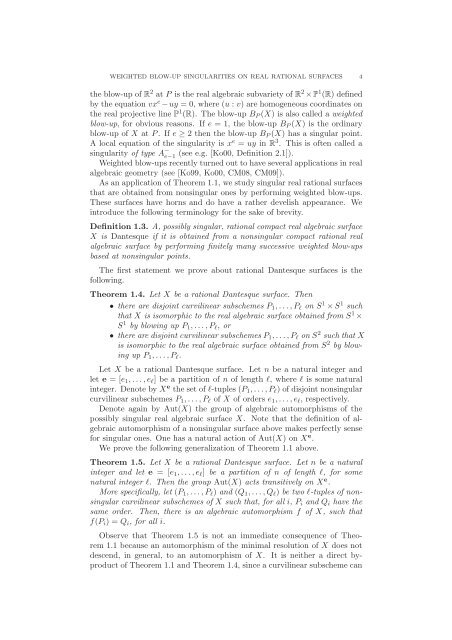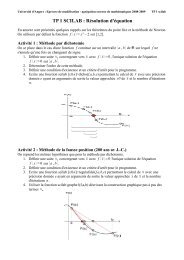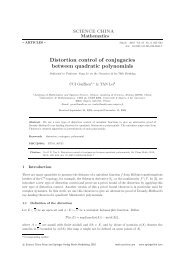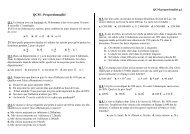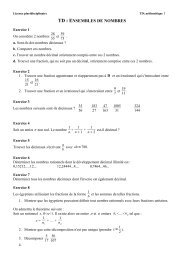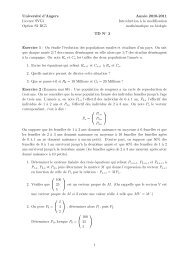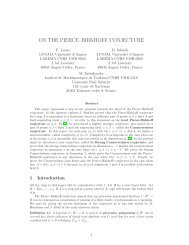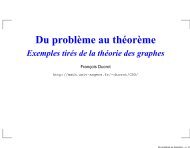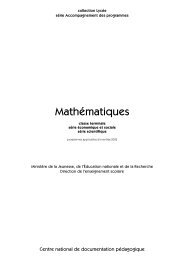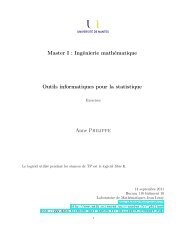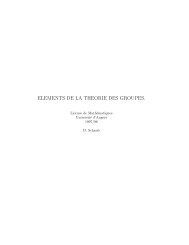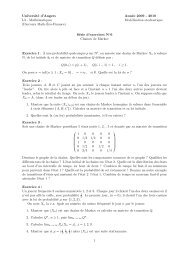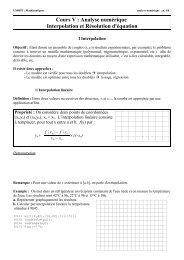automorphisms of real rational surfaces and weighted blow-up ...
automorphisms of real rational surfaces and weighted blow-up ...
automorphisms of real rational surfaces and weighted blow-up ...
Create successful ePaper yourself
Turn your PDF publications into a flip-book with our unique Google optimized e-Paper software.
WEIGHTED BLOW-UP SINGULARITIES ON REAL RATIONAL SURFACES 4<br />
the <strong>blow</strong>-<strong>up</strong> <strong>of</strong> R2 at P is the <strong>real</strong> algebraic subvariety <strong>of</strong> R2 ×P1 (R) defined<br />
by the equation vxe −uy = 0, where (u : v) are homogeneous coordinates on<br />
the <strong>real</strong> projective line P1 (R). The <strong>blow</strong>-<strong>up</strong> BP(X) is also called a <strong>weighted</strong><br />
<strong>blow</strong>-<strong>up</strong>, for obvious reasons. If e = 1, the <strong>blow</strong>-<strong>up</strong> BP(X) is the ordinary<br />
<strong>blow</strong>-<strong>up</strong> <strong>of</strong> X at P. If e ≥ 2 then the <strong>blow</strong>-<strong>up</strong> BP(X) has a singular point.<br />
A local equation <strong>of</strong> the singularity is xe = uy in R3 . This is <strong>of</strong>ten called a<br />
singularity <strong>of</strong> type A − e−1<br />
(see e.g. [Ko00, Definition 2.1]).<br />
Weighted <strong>blow</strong>-<strong>up</strong>s recently turned out to have several applications in <strong>real</strong><br />
algebraic geometry (see [Ko99, Ko00, CM08, CM09]).<br />
As an application <strong>of</strong> Theorem 1.1, we study singular <strong>real</strong> <strong>rational</strong> <strong>surfaces</strong><br />
that are obtained from nonsingular ones by performing <strong>weighted</strong> <strong>blow</strong>-<strong>up</strong>s.<br />
These <strong>surfaces</strong> have horns <strong>and</strong> do have a rather develish appearance. We<br />
introduce the following terminology for the sake <strong>of</strong> brevity.<br />
Definition 1.3. A, possibly singular, <strong>rational</strong> compact <strong>real</strong> algebraic surface<br />
X is Dantesque if it is obtained from a nonsingular compact <strong>rational</strong> <strong>real</strong><br />
algebraic surface by performing finitely many successive <strong>weighted</strong> <strong>blow</strong>-<strong>up</strong>s<br />
based at nonsingular points.<br />
The first statement we prove about <strong>rational</strong> Dantesque <strong>surfaces</strong> is the<br />
following.<br />
Theorem 1.4. Let X be a <strong>rational</strong> Dantesque surface. Then<br />
• there are disjoint curvilinear subschemes P1,...,Pℓ on S 1 × S 1 such<br />
that X is isomorphic to the <strong>real</strong> algebraic surface obtained from S 1 ×<br />
S 1 by <strong>blow</strong>ing <strong>up</strong> P1,... ,Pℓ, or<br />
• there are disjoint curvilinear subschemes P1,...,Pℓ on S 2 such that X<br />
is isomorphic to the <strong>real</strong> algebraic surface obtained from S 2 by <strong>blow</strong>ing<br />
<strong>up</strong> P1,...,Pℓ.<br />
Let X be a <strong>rational</strong> Dantesque surface. Let n be a natural integer <strong>and</strong><br />
let e = [e1,... ,eℓ] be a partition <strong>of</strong> n <strong>of</strong> length ℓ, where ℓ is some natural<br />
integer. Denote by X e the set <strong>of</strong> ℓ-t<strong>up</strong>les (P1,...,Pℓ) <strong>of</strong> disjoint nonsingular<br />
curvilinear subschemes P1,... ,Pℓ <strong>of</strong> X <strong>of</strong> orders e1,... ,eℓ, respectively.<br />
Denote again by Aut(X) the gro<strong>up</strong> <strong>of</strong> algebraic <strong>automorphisms</strong> <strong>of</strong> the<br />
possibly singular <strong>real</strong> algebraic surface X. Note that the definition <strong>of</strong> algebraic<br />
automorphism <strong>of</strong> a nonsingular surface above makes perfectly sense<br />
for singular ones. One has a natural action <strong>of</strong> Aut(X) on X e .<br />
We prove the following generalization <strong>of</strong> Theorem 1.1 above.<br />
Theorem 1.5. Let X be a <strong>rational</strong> Dantesque surface. Let n be a natural<br />
integer <strong>and</strong> let e = [e1,...,eℓ] be a partition <strong>of</strong> n <strong>of</strong> length ℓ, for some<br />
natural integer ℓ. Then the gro<strong>up</strong> Aut(X) acts transitively on X e .<br />
More specifically, let (P1,... ,Pℓ) <strong>and</strong> (Q1,... ,Qℓ) be two ℓ-t<strong>up</strong>les <strong>of</strong> nonsingular<br />
curvilinear subschemes <strong>of</strong> X such that, for all i, Pi <strong>and</strong> Qi have the<br />
same order. Then, there is an algebraic automorphism f <strong>of</strong> X, such that<br />
f(Pi) = Qi, for all i.<br />
Observe that Theorem 1.5 is not an immediate consequence <strong>of</strong> Theorem<br />
1.1 because an automorphism <strong>of</strong> the minimal resolution <strong>of</strong> X does not<br />
descend, in general, to an automorphism <strong>of</strong> X. It is neither a direct byproduct<br />
<strong>of</strong> Theorem 1.1 <strong>and</strong> Theorem 1.4, since a curvilinear subscheme can


